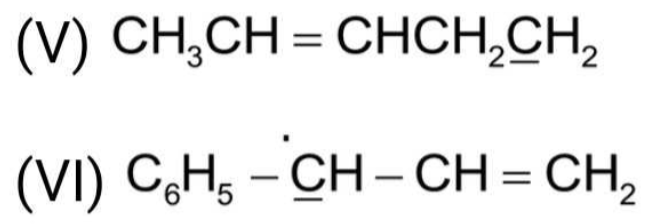how are free radicals formed?
Step-by-Step Solution:
1. Understanding Free Radicals: Free radicals are highly reactive species that contain unpaired electrons. They are formed when a molecule undergoes a process that results in the generation of these unpaired electrons.
2. Homolytic Fission: The primary method of free radical formation is through a process called homolytic fission. This occurs when a covalent bond between two atoms breaks evenly, resulting in the formation of two free radicals.
3. Mechanism of Homolytic Fission:
- In homolytic fission, each atom involved in the bond takes one of the shared electrons.
- For example, consider a diatomic molecule (e.g., Cl₂). When it undergoes homolytic fission, the bond breaks, and each chlorine atom takes one electron from the bond, resulting in two chlorine free radicals (Cl•).
4. Conditions for Free Radical Formation:
- Homolytic fission typically occurs in the presence of heat, light, or certain reagents that can facilitate the breaking of bonds.
- It is often favored in non-polar solvents, where the stability of the free radicals can be maintained.
5. Role of Reagents: Certain reagents can catalyze the process of homolytic fission, making it easier for the bond to break and for free radicals to form.
6. Conclusion: In summary, free radicals are formed through the process of homolytic fission, where a covalent bond breaks evenly, allowing each atom to retain one electron, resulting in the formation of two free radicals.
- In homolytic fission, each atom involved in the bond takes one of the shared electrons.
- For example, consider a diatomic molecule (e.g., Cl₂). When it undergoes homolytic fission, the bond breaks, and each chlorine atom takes one electron from the bond, resulting in two chlorine free radicals (Cl•).
- Homolytic fission typically occurs in the presence of heat, light, or certain reagents that can facilitate the breaking of bonds.
- It is often favored in non-polar solvents, where the stability of the free radicals can be maintained.
Topper's Solved these Questions
- BOOK - CBSE COMPLEMENTARY MATERIALCHAPTER - ORGANIC CHEMISTRY: SOME BASIC PRINCIPLES AND TECHNIQUESEXERCISE - 3 marks question6videos
ORGANIC CHEMISTRY: SOME BASIC PRINCIPLES AND TECHNIQUES
- BOOK - CBSE COMPLEMENTARY MATERIALCHAPTER - ORGANIC CHEMISTRY: SOME BASIC PRINCIPLES AND TECHNIQUESEXERCISE - 3 mark questions5videos
ORGANIC CHEMISTRY: SOME BASIC PRINCIPLES AND TECHNIQUES
- BOOK - CBSE COMPLEMENTARY MATERIALCHAPTER - ORGANIC CHEMISTRY: SOME BASIC PRINCIPLES AND TECHNIQUESEXERCISE - 1 mark question36videos
ORGANIC CHEMISTRY: SOME BASIC PRINCIPLES AND TECHNIQUES
- BOOK - CBSE COMPLEMENTARY MATERIALCHAPTER - HYDROGENEXERCISE - Unit Test11videos
HYDROGEN
- BOOK - CBSE COMPLEMENTARY MATERIALCHAPTER - P-BLOCK ELEMENTSEXERCISE - UNIT TEST8videos
P-BLOCK ELEMENTS
Similar Questions
Knowledge Check
- Question 1 - Select One or More
In which cases, free radicals can be formed by homoytic fission?
AH3C−O∣∣C−CH3hv−−→BR−N=N−Rhv−−→C DCH3−O−O−CH3hv−−→
DCH3−O−O−CH3hv−−→ - Question 2 - Select One
Chlorine free radicals react with methane by
Adonating their free-radicals electron to methane to from chloromethaneBabstracting a hydrogen atom form methane, and producing HCI and methyl radicalCforming a carbanion intermediate that rapidly dissociates to produce chloromethaneDforming a carbonium ion intermediate that reapidly dissociate to from chloromethane - Question 3 - Select One
The intermediates formed in free radical polymerisation depends on_____________.
AmonomerBinitiatorCchain terminating agentDboth (A) and (B)
what are the free radicals? justify the stability of the aliphatic primary secondary and tertiary free radicals
View SolutionHow many of the following free radicals are more stable than C6H5−CH−CH3 ? (underlined carbon is free radical carbon)




 View Solution
View SolutionFree radicals are formed through
View SolutionWhich of the following compound will form free radical very readily ?
View Solution
In which amongs the following product is formed by free radical mechanism ?View Solution

